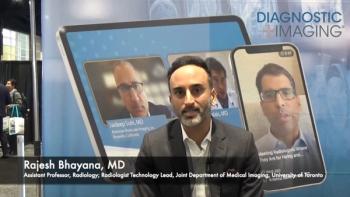
Signostics readies palm-sized ultrasound for U.S. launch
Other headlines: Cardiac cath usage declinesViztek launches mammo PACS viewer
Signostics readies palm-sized ultrasound for U.S. launch
An ultrasound scanner so small it fits in the palm of your hand will soon enter the U.S. market from industry newcomer Signostics. The Australian firm has gotten the go-ahead from the FDA to market the "personal ultrasound" scanner, which the company plans to package as a cost-effective device for individual health professionals to use in their clinical practices. The scanner weighs about half a pound and will be priced at a fraction of the cost of cart-based systems, according to the firm. Primary targets are emergency medicine, primary care, remote healthcare, critical care, pediatrics, musculoskeletal, palliative care, and sports medicine. Signostics will tout applications including assessment of trauma patients and abdominal aortic aneurysm screening, as well as basic obstetric exams, such as pregnancy viability and fetal positioning. Physician-engineer Dr. Neil Bartlett founded Signostics in Adelaide, Australia, in January 2005, later establishing a U.S. office in Palo Alto, CA. The company has raised about $8 million from angel investors, Australian government grant providers, and Playford Capital. Another $4 million is expected to close shortly.
Cardiac cath usage declines
The number of cases handled in cath labs is going down, according to a recent survey performed by IMV, a market research firm in Des Plaines, IL. These labs had shown steady growth, but the pattern changed direction abruptly in 2007, falling about 10% that year and another 1% the next. IMV linked the decline to the advent of CT coronary angiography, but noted that other factors may be involved. These include a controversy over the use of drug-eluting stents that developed around 2005-2006, which may have reduced the number of therapeutic coronary cases, and increased use of pre-authorization policies by third-party insurers.
Viztek launches mammo PACS viewer
A new full-featured mammography viewer from Viztek will be marketed to work with the company's Opal-RAD PACS, as well as any other PACS supporting DICOM query/retrieve for mammography. The viewer, which is configurable for simultaneous gray scale and color, can display breast images from full-field digital mammography systems, computed radiography, and MR. Major computer-aided detection systems can be launched from the viewer toolbar.
Newsletter
Stay at the forefront of radiology with the Diagnostic Imaging newsletter, delivering the latest news, clinical insights, and imaging advancements for today’s radiologists.




























